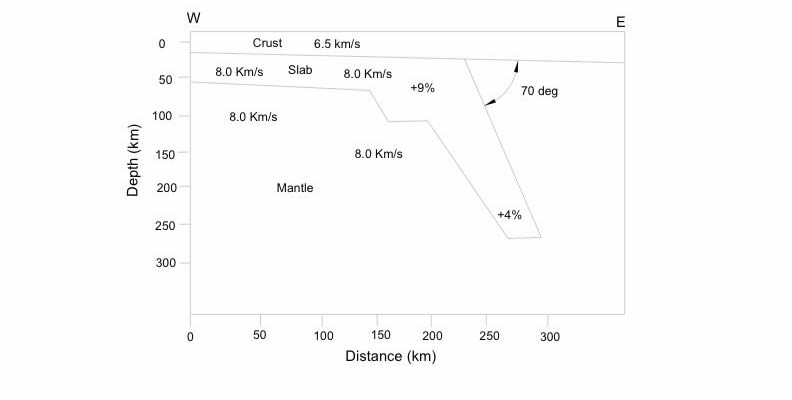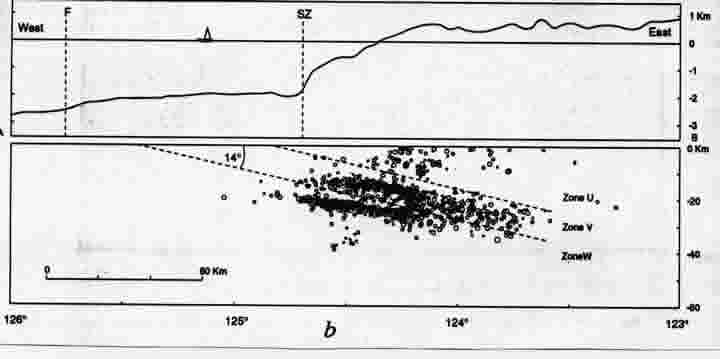
Constrains from seismology
Geometry of the Gorda Plate and slab
The first evidence of the existence of a slab associated to the Gorda Plate is the fact that the seismicity near the MTJ is not correlated with surface faults. The seismicity shows a slab dipping toward the east at shallow angles (Smith et al, 1993). Azimutal dependence of the travel-time residuals from teleseismic data found by Benz et al (1992), also shows the presence of the slab beneath northamerica. They interpreted the large negative residuals that appear for teleseismic rays coming from the east as a consequence of the high velocity of the east dipping slab that the seismic rays have to travel trough. Interpretations of the local earthquake tomography by Verdonck and Zandt (1994) associate the subducting Gorda Plate with a high gradient in the P-wave seismic velocities (between 6 and 7 km/s).
High P wave velocity anomalies revealed that presumably the Gorda
Plate has a shallow dip near Cape Mendocino, but it gets steeper to the east.
Figure 5 shows a geometry of the subducting plate proposed by Benz
et al (1992); this configuration minimizes the misfit between teleseismic
P wave theoretical residuals (differences between the expected arrival time
and the arrival time obtained from a forward ray tracing modeling) and the observed
residuals. It can be seen that there is a thinning of the slab with depth, indicating
assimilation of the slab into the mantle. The local thickening just where the
slope of the slab changes is consistent with the tomographic images (a thick
body of high seismic velocity) obtained by these authors.

Figure 5 (Modified from Benz et al, 1992): Geometry of the Gorda Slab and velocity model for an east-west profile just north of the MTJ. Velocity perturbations in the shallow portion of the slab are +9% (with respect to 8.0 km/s) and in the deep portions of the slab are +4%.
The local earthquake tomography suggests that the top of the Gorda Plate is between 15 and 20 km deep in the Cape Mendocino area, with a subduction angle of nearly 8 degrees (Verdonck and Zandt, 1994). Velocity anomalies near the southern end of the Gorda Plate found in the same study, are interpreted as a southward flexure in the slab, with dips between 6 and 12 degrees. Refraction and reflection data show that subduction go at least as far as 150 km inboard from the trench (Beaudoin et al, 1996). Verdonck and Zandt (1994) define the southern edge of the slab as the termination of the Benioff seismicity, occurring along a strike of N105E. Anomalies in the teleseismic P wave velocity as well as the presence of seismic reflectors in the upper mantle suggest the possibility of the existence of fragments of the Gorda Slab south of the MTJ (Benz et al, 1992).
Seismic refraction profiling shows that the Gorda Plate thickens northward, with its crust going from around 7 km thick near the Mendocino Fault Zone, to 10 km thick at locations of around 120 km north of the fault zone. Beaudoin et al (1994), attribute this fact to the possibility that part of the sedimentary cover of the Gorda Plate was scrapped off by the Mendocino Fault. The thickness of the plate beneath Cape Mendocino is around 40 km.
Seismic profiling (Beaudoin et al, 1996 ) shows that there is a thickening of the Franciscan Complex at the western end of the North-American Plate because of the passage of the MTJ in its northward motion, as a response to compressional stresses associated with the subduction. South of the MTJ there is a thinning of the Franciscan Complex, possibly associated with upwelling of the asthenosphere in the slab window.
Slab window
The slab window is believed to be present east of the San Andreas Fault and south of the MTJ. One of the most clear seismic evidences of the existence of the slab window comes from teleseismic tomography. High negative P wave velocity anomalies are present in the expected area for horizontal sections at depths between 30 and 70 km, suggesting that hot asthenospheric material is filling the gap (Benz and Zandt, 1993). Beaudoin et al (1996) report the presence of a deep reflector in an east-west seismic profile, just south of the MTJ. Their interpretation is that it can be either the Pacific Plate underlying North-America or newly accreted asthenospheric material resulting from the slab window.
Triangular wedge in the vicinity of the MTJ
In the Benioff seismicity associated with the subducting Gorda plate at the latitude of Cape Mendocino, a thin layer with no seismicity can be distinguished (Smith et al, 1993, figure 7). Smith et al (1993) suggest that this double seismic zone reflects an eastward migration of the Cascadian Subduction Zone , associated with the eastward jump of the MTJ. The earthquakes would be concentrated along the two planes of weakness resulting from the two successive Benioff planes. Figure 6 illustrates this situation.

Figure 6 (from Smith et al, 1993). East- West profile at the latitude of the mendocino Fault zone showing the double seismogenic layer found associated to the Gorda Slab. The dashed lines are for separation of data but do not represent the subducting gorda plate. SZ denotes the seaward edge of the Cascadia Subduction Zone.

Figure 7 (modified from Smith et al, 1993). Interpretation of the origin of the double seismic zone. Migration to east of the San Andreas Fault and the MTJ will also cause a displacement of the subduction zone. NSZ: New subduction zone, OSZ: Old subduction zone. The hatched region represents the wedge of continental material subducting under North-America.
The double seismicity layer can also be interpreted as a ductile lower crust between brittle upper crust and upper mantle, and in that case it would not have any relation with the eastward jump of the MTJ and the formation of the triangular wedge.
Faults in the triple junction
South of the MTJ, Benz et al (1993)
interpreted the high P wave velocity perturbations in the upper mantle as Pacific
plate partially subducting beneath the western edge of North America. Using
only information from local earthquakes, Verdonck
and Zandt (1994) postulate the underplating of the Pacific crust underneath
the Franciscan Complex (North-American plate).
Results from active source seismic tomography (Hole
et al, 2000) show that there is a mafic layer (high seismic velocity) in
the lower part of the three plates in the MTJ area, but at different depths
for each plate. Seismic tomography shows a steep slope in this layer in the
vicinities of the faults, suggesting that the faults are vertical, given the
fact that those steep slopes can be interpreted as near vertical offsets. This
seems to indicate that at the latitude of the MTJ there should be no extension
of the Pacific Plate beneath North America. However, the question about the
origin of the high velocity layer in the lower part of the North - American
plate still remains.
Go to:
contents intro history techniques references